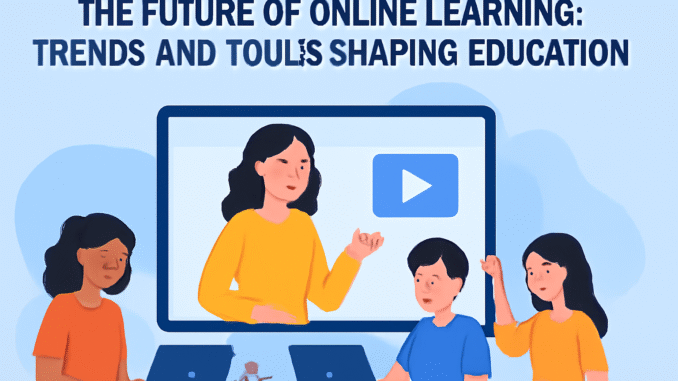
The Future of Online Learning: Trends and Tools Shaping Education
The landscape of education has undergone a significant transformation in recent years, largely fueled by the rise of online learning. With the rapid development of digital technologies and the increasing need for flexibility in education, online learning has grown from a niche alternative to a mainstream mode of instruction. In 2025, online education is expected to continue evolving, offering new tools and trends that shape how students engage with learning and how educators deliver content.
In this article, we explore the future of online learning, the emerging trends that are influencing the field, and the tools that are making it all possible. From adaptive learning systems to virtual classrooms, the way we learn and teach is being redefined.
1. The Rise of Hybrid and Blended Learning Models
One of the most prominent trends in online learning is the shift toward hybrid or blended learning models. Rather than fully remote or completely in-person classes, hybrid learning combines elements of both. This approach allows students to learn online at their own pace while still having access to in-person support when necessary. For example, students might watch lectures online and then attend live, virtual office hours for one-on-one assistance with instructors.
The hybrid model is particularly appealing for higher education institutions that are trying to balance the advantages of face-to-face interaction with the flexibility of online education. As we approach 2025, more schools and universities will adopt hybrid models to meet the diverse needs of their student populations, especially as demand for flexible learning continues to rise.
2. Artificial Intelligence (AI) and Personalized Learning
Artificial Intelligence (AI) is already making waves in many industries, and education is no exception. In the future, AI will become even more integral to online learning, particularly in creating personalized learning experiences for students. AI tools can analyze students’ learning habits, preferences, and performance to provide real-time feedback and tailored learning paths. This allows students to learn at their own pace while addressing any knowledge gaps.
For example, adaptive learning platforms powered by AI can recommend resources, quizzes, or interactive activities based on a student’s current performance. AI can even predict when a student might struggle with a concept, offering support or adjusting the difficulty of tasks. These personalized learning environments make online education more engaging, helping students stay motivated and succeed.
3. Gamification: Making Learning Fun and Engaging
Incorporating gamification into online education is a trend that is expected to gain momentum in the future. Gamification involves using game design elements—such as points, levels, leaderboards, and badges—to enhance the learning experience. The idea is to make learning more fun, interactive, and rewarding, which increases student engagement and motivation.
In the future, online platforms will integrate more game-based elements into their curriculum, from interactive quizzes to entire learning modules designed like video games. For example, students may engage in scenario-based learning where they face challenges or “missions” to solve real-world problems. This not only makes learning more engaging but also helps develop critical thinking, problem-solving, and teamwork skills in a low-pressure, enjoyable environment.
4. Immersive Learning: Virtual Reality (VR) and Augmented Reality (AR)
Virtual Reality (VR) and Augmented Reality (AR) are changing the way students interact with online content. These immersive technologies allow learners to experience education in a way that is far beyond what traditional video lectures or readings can provide. For instance, VR allows students to step inside a simulation or virtual field trip, experiencing complex environments like historical sites, outer space, or the human body.
AR, on the other hand, overlays digital information onto the real world, enhancing learning experiences. For example, in an online biology class, students could use AR to explore 3D models of cells or organs. As these technologies become more accessible and affordable, VR and AR will play a pivotal role in shaping the future of online education, providing richer, more engaging learning experiences.
5. Collaborative Learning and Social Interaction
While online learning is often associated with solitary study, the future of online education will emphasize collaborative learning and social interaction. Online classrooms of the future will make it easier for students to interact, collaborate on projects, and engage in real-time discussions. Tools like discussion forums, group video chats, and collaborative documents will continue to enhance social learning opportunities, breaking down the barriers of isolation that can come with online education.
Moreover, the ability to connect with peers globally is one of the most exciting aspects of online learning. Students can engage in international discussions, share diverse perspectives, and work together on projects that cross borders. This fosters a sense of community, collaboration, and global awareness that is not always possible in traditional in-person classrooms.
6. Microlearning: Bite-Sized Content for Flexible Learning
In the future, microlearning will play a significant role in online education. Microlearning involves delivering content in short, focused segments, allowing students to learn at their own pace and on their own schedule. Rather than spending hours on a single lesson, students will be able to access brief videos, quizzes, or articles that cover a specific concept in a matter of minutes.
This trend caters to the fast-paced world we live in, where attention spans are shorter, and students often need quick bursts of information to retain knowledge. Microlearning makes it easier for students to learn in smaller, digestible portions, which improves focus, retention, and engagement. It’s also a great option for busy professionals or lifelong learners who need to fit education into their hectic schedules.
7. AI-Powered Assessment and Feedback
Assessment in online learning will undergo a major transformation in the coming years, thanks to AI-powered assessment tools. Traditional exams and quizzes often fail to measure a student’s true understanding, but AI can provide more accurate, dynamic assessments. For instance, AI can evaluate a student’s problem-solving abilities, creativity, and critical thinking skills by analyzing their responses to open-ended questions, projects, or simulations.
AI tools will also provide real-time feedback, helping students identify areas of improvement and track their progress over time. By providing immediate insights into performance, AI tools ensure that students receive the support they need in a timely manner, allowing them to adjust their learning strategies before it’s too late.
8. Blockchain Technology for Credentials and Certifications
One of the most exciting developments for online education is the integration of blockchain technology for verifying credentials and certifications. Blockchain provides a secure, decentralized system for tracking and storing academic records, making it easier for employers, universities, and organizations to verify the authenticity of a student’s qualifications.
In the future, students will be able to earn digital credentials that are stored on a blockchain, providing a permanent, verifiable record of their achievements. This technology could also lead to a more transparent and global recognition system for online courses, creating new opportunities for learners worldwide.
9. Learning Analytics: Data-Driven Insights for Improved Learning
Learning analytics involves the collection and analysis of data to understand and improve the learning process. In the future, online education platforms will harness the power of big data to provide actionable insights that help educators tailor their teaching methods and students make more informed decisions about their learning journey.
By tracking student progress, engagement, and performance across various metrics, learning analytics can identify patterns and trends that may not be immediately visible. For example, teachers can use data to spot struggling students and intervene early, while students can access reports that highlight their strengths and areas for improvement.
10. Global Learning Ecosystems
As the world becomes more interconnected, the future of online learning will be characterized by global learning ecosystems. These ecosystems will link together various online platforms, institutions, and educational technologies, creating a seamless experience for learners, educators, and administrators alike.
In the future, learners will have access to a wide array of online courses, certifications, and degree programs from universities and institutions around the world. These global learning networks will offer students the ability to create a personalized learning path, tapping into the best resources and courses available globally, without geographical limitations.
Conclusion: The Future of Online Learning is Bright
The future of online learning is full of promise, offering exciting opportunities for students and educators alike. By embracing emerging technologies, adopting new pedagogical strategies, and fostering collaboration, online education will continue to evolve in ways that make learning more personalized, accessible, and engaging.
As we move into 2025, the trends and tools shaping online learning will redefine how we approach education. From AI-powered systems to immersive VR classrooms, the educational landscape will be vastly different from what we know today. For students, this means greater flexibility, personalized learning experiences, and more interactive, engaging content. For educators, it means new tools and technologies that empower them to reach and teach students in innovative ways.
The future of online learning is not just about technology—it’s about creating an educational experience that prepares learners for the challenges of tomorrow’s world, while fostering curiosity, creativity, and collaboration.

